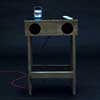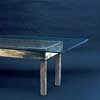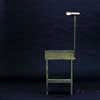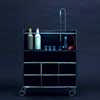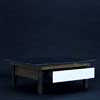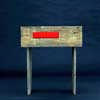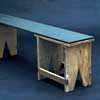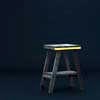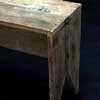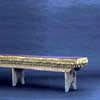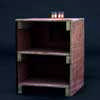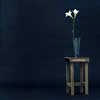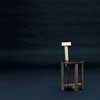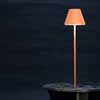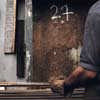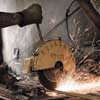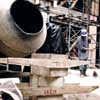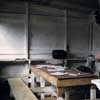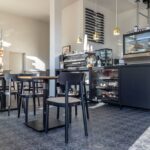Prostheses and Grafts Furniture, Micasa Design, Project, Photo, News, Design, Image
Prostheses and Grafts Furniture by StudioMK27, Brazil
Micasa Furniture – Prostheses and Grafts : Architecture Information
23 Aug 2012
London Design Festival – Prostheses and Innesti
As part of London Design Festival, StudioMK27 will have their furniture collection Prostheses and Innesti (Protesi e Innesti) shown at Fumi gallery in Hoxton Square, London.
Micasa Furniture
Radiola Table
Bench-table with Ipod dock
Abuletada Table
Table for the dining room with a glass table-top
Alumiada Table
Table-bench with a copper luminary and carbon filament light-bulb
Trilili Bar-Wagon
Accessory box with stainless steel strip and industrial castors
Vai-te-mundo Hat Stand
Hat Stand with metallic suspenders
Toró Umbrella Stand
Wooden basket with chromium-plated metallic finish
Escambau Table
Low table with a mirrored-drawer finish
Quereres Table
Table-bench with a wooden jewellery box in red synthetic enamel
23 Mar 2010 – Launch
Próteses e Enxertos : Prostheses and Grafts
Introduction
The collection “Prostheses and Grafts” was ideated by the team of architects of StudioMK27. The furniture is from the project sites of the office, constructed anonymously by civil construction laborers in Brazil. All of the furniture in this exhibit was used at the sites. Normally, with the end of the construction, some of these pieces are lost and others are reused at other sites.
The furniture from the projects underwent some small interventions, realized in a precise and artisan manner. The project of interventions was a thought out case for each piece of furniture and there was a brief selection of the pieces gathered. Sixteen pieces comprise this collection, initially presented at Micasa VolB in March of 2010.
Chamego Bench
Benches joined together by a carbon fiber plate
Sampled Bench
Bench with gold-plated strip to replace wooden strip.
Pregado Bench
Bench-table fixed with golden nails
Luizão XV Bench
Large bench with velvet cushion and golden details
Dá Hora Table
Bench-table with a valve-numbered clock
Fulo Table
Table-bench with a laboratory glassware vase
Bo Benchette
Child’s bench with giraffe back
Luzlino Table
Bench-table with night-lamp
The extremely necessary and art
Gabriel Kogan
“I don’t understand any of this. For me popular art is non-existent. Out of necessity people do things that are related to life”
Lina Bo Bardi
Popular design in the XXI century has suffered in the midst of the accelerated urbanization and globalization of the capitals. The folkloric object, as well as the local know-how itself, has been swallowed by a torrent of information in the contemporary world. Among the glimmer of exceptions which have quickly disappeared, still alive is the nostalgic imaginary existence of a popular urban culture. More than just the mystification of an autonomous production, there exists the theoretical desire to formulate an authentically national design, a Brazilian design.
Nonetheless, a careful examination of these remnant popular objects indicates to us a characteristic that is surprisingly universal. Contrary to modern thinking, the people’s design does not emerge from a maximum economy of the material, but rather from something delicately different: the solutions arise from the simplest extremely necessary work. If, on the one hand, the raw material of this production is almost always derived from that which has been discarded, from junk, on the other the form of constructing and manipulating the material is an ingenuity about the functionality of the object, in which the finished product holds a memory of the very material that is now in a useful form.
This exhibit presents a vestige of the popular culture found in large cities. The furniture was built by civil construction laborers, in the city of São Paulo, for their own use. They are pieces, abundant at the sites, almost always made from the discarded wood of the project. The furniture is composed of pieces that are in themselves finished, functionally perfect. However for this exhibit, they are not displayed in their whole form, but rather with small interferences meticulously executed by an artisan. In any one object there are opposing things juxtaposed, the design of necessity and art, in a manner that exposes both more clearly.
The furniture of the project becomes, then, that which it was not: precious and unique pieces. But through this transformation, from small grafts, the rough and perfectly functional nature of these pieces is revealed to us; and the painstaking and protracted grafting, is the very exception. For these interferences there was a deliberate search for the use of industrial materials that demonstrate the rusticity of the discarded wood and, in contrast, the precision of metal. In this way, a distant discourse is summoned about the relation between industry and life, between handicrafts and function, which are in the origins of modernist thinking.
Perhaps this exhibit hopes to be a testimony of know-how and practices in extinction.
Mesa Alumiada detail ; Mesa Quereres det. ; Abuletada Table det. ; Luzlino Table det.
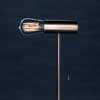
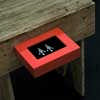
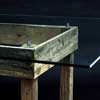
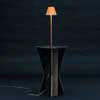
RE-doing everything: imaginative competence and the spontaneous design of civil construction laborers
Maria Cecilia Loschiavo
An unexpected email from Mariana and a fortuitous meeting with Gabriel brought me the news about this opportune exhibit. I am inclined to agree with the poet: “The random will protect us”.
The showing of this 15-piece collection is but a small sample of the extraordinary repertoire of objects designed and constructed by some civil construction laborers in our country. Although displaced from their lócus vivendi, these pieces place before us the absolute imaginative competence of anonymous authors, revealing the functional strategies used to adapt to work and life within the confines of the project sites.
On every day and at every site these workers improvised, producing “ingenuities” of every type: to sit, to rest, to heat food, to hang and dry clothing and to re-use the remnants and the rests of material that the very project discarded. The main characteristic of these pieces are the bricolage, the spontaneous design, the re-using of materials.
In his book “The Savage Mind” Levi-Strauss explains that the
“bricoleur (handyman) is someone who works with his hands and uses means (convoluted, cunning) diverse from those used by the artisan […]. The bricoleur (handyman) can perform a large number of tasks, but, different than the engineer, he is not subordinated to the availability of materials or the tools designed and necessary for the proposed project” (Lévi-Strauss, 1966).
This logic is manifested in the spontaneous design and the creative practice of finding the solutions applicable to the resolution of concrete problems in the context of a severe lack of resources” (Loschiavo dos Santos, 2000).
The young architects and designers of StudioMK27 have always been mindful of the wealth of this design and had begun collecting some pieces originating from the sites of their own projects deciding, then, to introduce small modifications and to increment new elements which, in turn, offered new meanings and mew materiality to the pieces. In this way they promoted a re-doing of the objects from the sites, prolonging the short and brief existence of these pieces and initiating, as well, a new circuit of circulation and aesthetic fruition.
It is important to emphasize that the addition of industrialized elements to the original pieces provoke an effect of contrasts and de-familiarization, an unexpected conflagration of the materials that connect numerous temporalities, identities and new functions. In most of the pieces constructed with the re-use of wood, there is some metal, some carbon fibers, some glass, causing us to re-think the transition of the products and the materials and, therewith, the very limits of the planet.
The names of the pieces are suggestive and signal these new interactions: Radiola Table, Degustex Table, Alumiada Table, Bar-Wagon Trilili, Vai-te-mundo Hat-Stand, Toró Umbrella-Stand, Escambau Table, Quereres Table, Chamego Bench, Amostrado Bench, Luizão XV Bench, Dá Hora Table, Fulô Table, Bo Bench and Luzlino Table.
These pieces illustrate the convergence of a series of themes: the possibility of using products for a longer period of time, without their deterioration; the diversity in re-using materials and products; the discarding and the imaginative force of spontaneous design in the answers and solutions in the quotidian of these civil construction laborers.
Prostheses and Grafts Furniture – Credits
StudioMK27 Team – Marcio Kogan + Beatriz Meyer, Carolina Castroviejo, Diana Radomysler, Eduardo Chalabi, Eduardo Glycerio, Gabriel Kogan, Lair Reis, Maria Cristina Motta, Mariana Simas, Oswaldo Pessano, Renata Furlanetto, Samanta Cafardo, Suzana Glogowski
Development and execution of prostheses and grafts – Álvaro Wolmer Movelaria Fina LTDA
Collaborators for the development and execution of prostheses and grafts – Daniel Alberto Lavaroni, Oswaldo Machado de Campos
Houssein Jarouche + MICASA Staff
Graphic Project: 20.87designworks, Gabriel Kogan
Photography: Reinaldo Coser, Gabriel Arantes and STUDIOMK27 Team
Texts: Maria Cecilia Loschiavo dos Santos, Gabriel Kogan
Drawer lining: Pascoal Mastrorocco
Upholsterer: Tapeçaria Bubi
Fabrics: JRJ
Lamp: Lumini
Translation: Rose Freifeld, StudioMK27 Secretary: Cristina Santocchi, Revision: Thaisa Burani
Acknowlegements: Fairbanks e Pilnik, Gárgola Engenharia, Lock Engenharia, MVC Engenharia Staffs. Shirley Paes Leme, Raquel Kogan. Special thanks to all of the civil construction laborers, the anonymous designers who made this furniture
Location:Brazil
Liquid Glacial Table

photograph : Jacopo Spilimbergo
Zaha Hadid Architecture Designs
Smart-ologic Corian® Living, Milan
Karim Rashid

photo : LeoTorri_DuPont_Corian
Milan Interior Design
Corian Lounge, Milan
Amanda Levete Architects
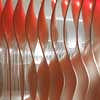
photo : LeoTorri_DuPont_Corian
Corian Lounge Design
Comments / photos for the Prostheses and Grafts Furniture Architecture page welcome
Prostheses and Grafts Furniture

